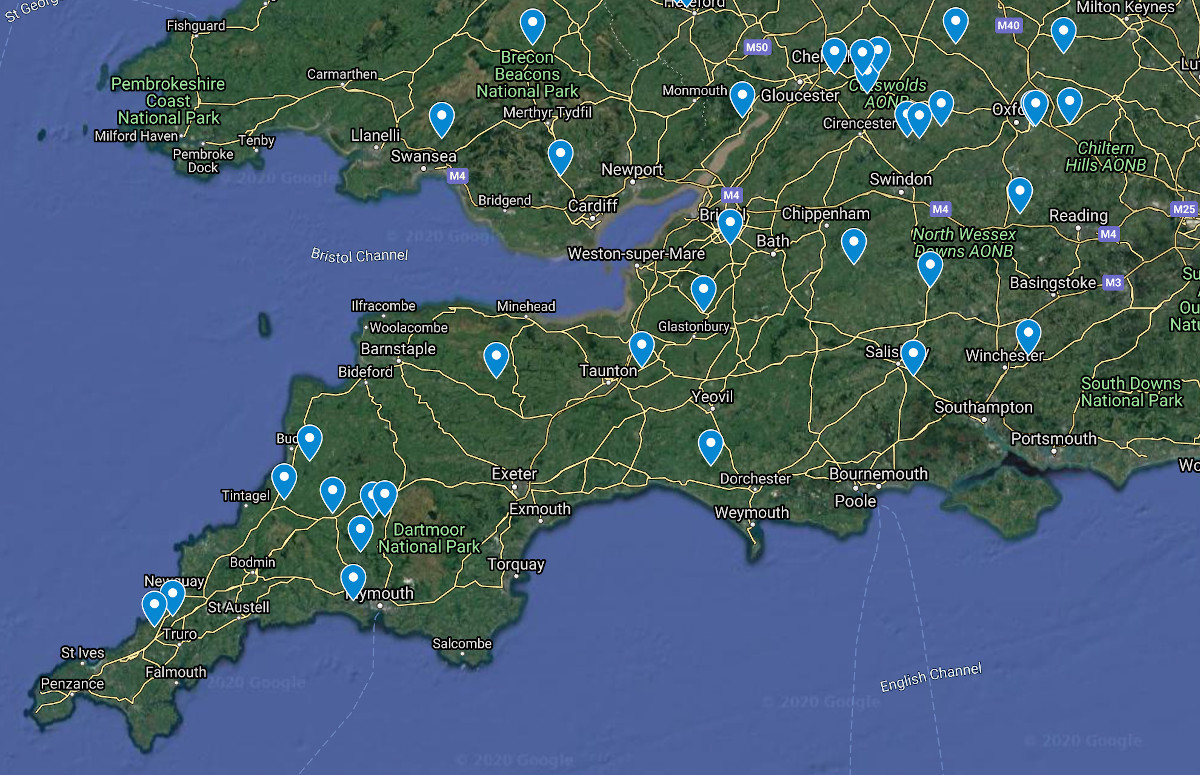| Re: Is Highways England the best guardian for rail heritage and dormant resource? Posted by CyclingSid at 07:10, 16th October 2023 |     |
and the total cost to the tax payer?
| Re: Is Highways England the best guardian for rail heritage and dormant resource? Posted by grahame at 21:12, 15th October 2023 |     |
From Lancs Live
'Vandalised' Cumbria railway bridge reopens two years after filled in with concrete
A Victorian railways bridge has finally reopened two years after National Highways filled it with concrete. The act was branded 'cultural vandalism'.
The Great Musgrave Bridge near Warcop was filled in by the highway agency in July 2021. The decision was made after fears the bridge could collapse.
Thousands of tons of concrete were poured into the 161-year-old bridge costing a whopping £124,000. But opponents said the work was taken "without justification" and the filling in would stop the bridge being used by walkers and cyclists.
This is just one of dozens of bridges that campaigners argue were infilled or demolished with no consideration taken about their heritage value. More than 800 people objected and Eden District Council issued an enforcement notice in September last year after refusing retrospective planning permission.
After listening to campaigners, work to remove the concrete started in July and the archway has been restored to was it once one. The bridge opened on Friday at 6pm.
A Victorian railways bridge has finally reopened two years after National Highways filled it with concrete. The act was branded 'cultural vandalism'.
The Great Musgrave Bridge near Warcop was filled in by the highway agency in July 2021. The decision was made after fears the bridge could collapse.
Thousands of tons of concrete were poured into the 161-year-old bridge costing a whopping £124,000. But opponents said the work was taken "without justification" and the filling in would stop the bridge being used by walkers and cyclists.
This is just one of dozens of bridges that campaigners argue were infilled or demolished with no consideration taken about their heritage value. More than 800 people objected and Eden District Council issued an enforcement notice in September last year after refusing retrospective planning permission.
After listening to campaigners, work to remove the concrete started in July and the archway has been restored to was it once one. The bridge opened on Friday at 6pm.
| Re: Is Highways England the best guardian for rail heritage and dormant resource? Posted by grahame at 11:21, 4th November 2022 |     |
From New Civil Engineer
National Highways scrutinised over four more historic bridge infills
National Highways is under pressure over four more controversial bridge infills which were carried out to historic structures before the infamous Great Musgrave fallout.
Campaigners claim that National Highways failed to obtain relevant planning consents for work on four historic bridges which were infilled using emergency powers between January 2019 and May 2021. National Highways disputes the claims and believes it does have the necessary consents for the infillings.
The HRE Group – an alliance of engineers, sustainable transport advocates and greenway developers – claims that the infillings have “questionable legal status” and is urging the four respective local authorities to assess whether National Highways should be ordered to reverse the work.
If the councils do issue enforcement orders for the infills to be removed, costs are likely to run into the millions.
National Highways is under pressure over four more controversial bridge infills which were carried out to historic structures before the infamous Great Musgrave fallout.
Campaigners claim that National Highways failed to obtain relevant planning consents for work on four historic bridges which were infilled using emergency powers between January 2019 and May 2021. National Highways disputes the claims and believes it does have the necessary consents for the infillings.
The HRE Group – an alliance of engineers, sustainable transport advocates and greenway developers – claims that the infillings have “questionable legal status” and is urging the four respective local authorities to assess whether National Highways should be ordered to reverse the work.
If the councils do issue enforcement orders for the infills to be removed, costs are likely to run into the millions.
| Re: Is Highways England the best guardian for rail heritage and dormant resource? Posted by paul7575 at 17:58, 17th June 2022 |     |
I can’t help thinking the anti-infill lobbyists need a better name. “HRE Group” just seems far too similar to the DfT’s responsible section, which I believe also goes by HRE.

Paul
| Re: Is Highways England the best guardian for rail heritage and dormant resource? Posted by Mark A at 12:44, 17th June 2022 |     |
After the planning decision, 2 minute useful piece of reflection from Graeme Bickerdike, filmed at Musgrave Bridge.
https://twitter.com/theHREgroup/status/1537478082864599043
Mark
| Re: Is Highways England the best guardian for rail heritage and dormant resource? Posted by Trowres at 23:47, 16th June 2022 |     |
Burying of Victorian bridge in Cumbria must be reversed, says council
https://www.theguardian.com/uk-news/2022/jun/16/burying-of-victorian-bridge-in-cumbria-must-be-reversed-says-council
The government’s road agency will be forced to remove hundreds of tonnes of concrete it used to bury a Victorian bridge arch despite offering a £450,000 sweetener to allow the controversial scheme to stay.
...
The planning committee’s decision means the agency will be required to reverse a project that submerged the 1862 bridge arch near Kirkby Stephen in 1,644 tonnes of gravel and concrete at a cost of £124,000. The council said it will now serve NH with an enforcement notice to restore the bridge to its previous state.
...
The planning committee’s decision means the agency will be required to reverse a project that submerged the 1862 bridge arch near Kirkby Stephen in 1,644 tonnes of gravel and concrete at a cost of £124,000. The council said it will now serve NH with an enforcement notice to restore the bridge to its previous state.
Worth following the link to see pictures of the "infill scheme".
| Re: Is Highways England the best guardian for rail heritage and dormant resource? Posted by CyclingSid at 06:47, 28th December 2021 |     |
If these are to be used for cycling and walking routes surely
failed an engineering assessment to carry 44-tonne
is a bit of an overkill. I know it is the festive season and I have been tucking in a bit, but ...| Re: Is Highways England the best guardian for rail heritage and dormant resource? Posted by ellendune at 10:04, 27th December 2021 |     |
On the other hand New Civil Engineer reports that they no longer intend to infill Barcombe bridge in East Sussex
| Re: Is Highways England the best guardian for rail heritage and dormant resource? Posted by grahame at 00:13, 27th December 2021 |     |
https://www.theconstructionindex.co.uk/news/view/bridge-infilling-preparations-continue-despite-supposed-pause
National Highways awarded 14 contracts in five weeks as preparatory works gather pace to infill or demolish dozens of Victorian bridges.
Contracts are being let despite ministers pausing the infilling programme in July.
National Highways says that it has indeed paused work as instructed – on site, that is, but not it seems in the planning. It is still pressing ahead with contract awards on the basis that it will be able to resume works in due course.
Contracts are being let despite ministers pausing the infilling programme in July.
National Highways says that it has indeed paused work as instructed – on site, that is, but not it seems in the planning. It is still pressing ahead with contract awards on the basis that it will be able to resume works in due course.
| Re: Is Highways England the best guardian for rail heritage and dormant resource? Posted by stuving at 22:39, 31st July 2021 |     |
From The Guardian
Victorian railway bridges that were due to be filled in with concrete in an act previously decried as “cultural vandalism” will be repurposed as part of a scheme to encourage walking and cycling, the UK transport secretary has announced.
The government is halting the demolition of historic train lines in the hope that they can be remodelled as routes which encourage greener means of travel.
Grant Shapps unveiled the summer of cycling and walking strategy on Friday, which proposed to improve related infrastructure around the UK – supported by a £338m budget.
It comes after a Highways England decision to pour concrete in a railway arch provoked anger from local residents, with the government-owned firm being told it may have to reverse the move.
The government is halting the demolition of historic train lines in the hope that they can be remodelled as routes which encourage greener means of travel.
Grant Shapps unveiled the summer of cycling and walking strategy on Friday, which proposed to improve related infrastructure around the UK – supported by a £338m budget.
It comes after a Highways England decision to pour concrete in a railway arch provoked anger from local residents, with the government-owned firm being told it may have to reverse the move.
That appears to be based on the day before yesterday's pre-announcement, as I can't find it in Grant Shapps's actual announcement of yesterday. Of course the timescale from Boris deciding this on Wednesday hardly allowed for its inclusion. As has become usual, the announced policy document - "the Summer of Cycling and Walking document published today" - hasn't been published yet. Presumably it will appear in a day or two, linked to so it appears to have been published today. Until then, we have just this:
Other key measures included in the Summer of Cycling and Walking include plans to publish a new road safety strategic framework and commitments to help train hundreds of new Bikeability instructors and explore how historic railway structures can be converted into cycle routes.
The government has also announced today that the new Active Travel England (ATE) commissioning body, which will hold the national cycling and walking budget, will begin work later this year.
The government has also announced today that the new Active Travel England (ATE) commissioning body, which will hold the national cycling and walking budget, will begin work later this year.
Maybe this ATE will fund HE to not take the cheap option with currently redundant highways bridges over potential cycle paths, though there is no such link implied in the text.
Correction to dates
| Re: Is Highways England the best guardian for rail heritage and dormant resource? Posted by grahame at 20:59, 31st July 2021 |     |
From The Guardian
Victorian railway bridges that were due to be filled in with concrete in an act previously decried as “cultural vandalism” will be repurposed as part of a scheme to encourage walking and cycling, the UK transport secretary has announced.
The government is halting the demolition of historic train lines in the hope that they can be remodelled as routes which encourage greener means of travel.
Grant Shapps unveiled the summer of cycling and walking strategy on Friday, which proposed to improve related infrastructure around the UK – supported by a £338m budget.
It comes after a Highways England decision to pour concrete in a railway arch provoked anger from local residents, with the government-owned firm being told it may have to reverse the move.
The government is halting the demolition of historic train lines in the hope that they can be remodelled as routes which encourage greener means of travel.
Grant Shapps unveiled the summer of cycling and walking strategy on Friday, which proposed to improve related infrastructure around the UK – supported by a £338m budget.
It comes after a Highways England decision to pour concrete in a railway arch provoked anger from local residents, with the government-owned firm being told it may have to reverse the move.
| Re: Is Highways England the best guardian for rail heritage and dormant resource? Posted by ellendune at 14:57, 23rd July 2021 |     |
From New Civil Engineer
The council states that:
“Whilst the provisions allow initial works to be undertaken in connection with an emergency, where such works are intended to be retained, retrospective planning permission must be sought. […] The Council’s acceptance of Highways England’s Permitted Development Rights does not constitute permission for the infilling to be retained. Planning processes will be followed and due consideration given to any future application in respect of the infilling of Great Musgrave Bridge.”
| Re: Is Highways England the best guardian for rail heritage and dormant resource? Posted by stuving at 10:41, 23rd July 2021 |     |
From The Guardian
The government’s roads agency could be forced to remove hundreds of tonnes of concrete it used to fill in a Victorian railway arch in a project that was condemned as the first act of “cultural vandalism” in a nationwide plan.
Eden district council told Highways England (HE) this week that it needs to apply for retrospective planning permission for a scheme that involved pouring an estimated 1,000 tonnes of concrete and aggregate under the bridge at Great Musgrave, Cumbria, at the start of nationwide programme to infill scores of historic structures.
If planning is refused, the agency will be obliged to restore the bridge to its state before the infill began at the end of May.
Eden district council told Highways England (HE) this week that it needs to apply for retrospective planning permission for a scheme that involved pouring an estimated 1,000 tonnes of concrete and aggregate under the bridge at Great Musgrave, Cumbria, at the start of nationwide programme to infill scores of historic structures.
If planning is refused, the agency will be obliged to restore the bridge to its state before the infill began at the end of May.
This was (part of) EDC's last media statement, (6th June):
In relation to whether these works require planning permission, it is important to note that Highways England do have permitted development rights to carry out certain works, without the need for the prior grant of planning permission. These rights would be covered in Part 9 and Part 19 of the Town and Country Planning (General Permitted Development) (England) Order 2015.
Eden District Council’s Planning Service has opened a dialogue with Highways England to understand the full extent, nature and reasoning for the proposed works at Great Musgrave, to ascertain whether the works do fall within Permitted Development Rights.
This is an ongoing matter and discussions have not yet concluded.
Once sufficient information has been provided by Highways England, the Planning Service will be able to judge whether these works do constitute a Permitted Development, or if they require the prior granting of planning permission. This information will inform what action, if any, can be taken in relation to these works.
Eden District Council’s Planning Service has opened a dialogue with Highways England to understand the full extent, nature and reasoning for the proposed works at Great Musgrave, to ascertain whether the works do fall within Permitted Development Rights.
This is an ongoing matter and discussions have not yet concluded.
Once sufficient information has been provided by Highways England, the Planning Service will be able to judge whether these works do constitute a Permitted Development, or if they require the prior granting of planning permission. This information will inform what action, if any, can be taken in relation to these works.
Since this will hinge on legal definitions - such as whether infilling a bridge is building or demolition, and whether its result has a "design" - I presume EDC has taken legal advice. Whether they want to fund a test case is another matter, though of course they might have a whip-round for it. There's more background in the Guardian.
| Re: Is Highways England the best guardian for rail heritage and dormant resource? Posted by grahame at 09:53, 23rd July 2021 |     |
From The Guardian
The government’s roads agency could be forced to remove hundreds of tonnes of concrete it used to fill in a Victorian railway arch in a project that was condemned as the first act of “cultural vandalism” in a nationwide plan.
Eden district council told Highways England (HE) this week that it needs to apply for retrospective planning permission for a scheme that involved pouring an estimated 1,000 tonnes of concrete and aggregate under the bridge at Great Musgrave, Cumbria, at the start of nationwide programme to infill scores of historic structures.
If planning is refused, the agency will be obliged to restore the bridge to its state before the infill began at the end of May.
Eden district council told Highways England (HE) this week that it needs to apply for retrospective planning permission for a scheme that involved pouring an estimated 1,000 tonnes of concrete and aggregate under the bridge at Great Musgrave, Cumbria, at the start of nationwide programme to infill scores of historic structures.
If planning is refused, the agency will be obliged to restore the bridge to its state before the infill began at the end of May.
| Re: Is Highways England the best guardian for rail heritage and dormant resource? Posted by MVR S&T at 00:09, 29th June 2021 |     |
Nice if they could get on with the ex railway bridge that takes the A35 over another road...
| Re: Is Highways England the best guardian for rail heritage and dormant resource? Posted by grahame at 22:43, 28th June 2021 |     |
But do you need planning permission to infill a bridge? I doubt it, unless it was listed by English Heritage.
Highways England says that the bridges concerned are among 200 to have failed an engineering assessment to carry 44-tonne lorries and, in the absence of weight restrictions, will have to be infilled or demolished on “urgent safety grounds” to “prevent an emergency arising.”
and that Highways England have emergency powers.There are examples where urgent safety ground are being invoked in this video:
| Re: Is Highways England the best guardian for rail heritage and dormant resource? Posted by stuving at 19:37, 15th June 2021 |     |
The current rules are in the famous Town and Country Planning (General Permitted Development) (England) Order 2015. Section 3 contains a number of special cases, none of which AFAICS is relevant here. The list of permitted developments for transport is in Schedule 2, part 8, of which this is the railways bit:
Class A – railway or light railway undertakings
Permitted development
A. Development by railway undertakers on their operational land, required in connection with the movement of traffic by rail.
Development not permitted
A.1 Development is not permitted by Class A if it consists of or includes—
(a)the construction of a railway;
(b)the construction or erection of a hotel, railway station or bridge; or
(c)the construction or erection otherwise than wholly within a railway station of—
(i)an office, residential or educational building, or a building used for an industrial process, or
(ii)a car park, shop, restaurant, garage, petrol filling station or other building or structure provided under transport legislation.
Interpretation of Class A
A.2 For the purposes of Class A, references to the construction or erection of any building or structure include references to the reconstruction or alteration of a building or structure where its design or external appearance would be materially affected.
Permitted development
A. Development by railway undertakers on their operational land, required in connection with the movement of traffic by rail.
Development not permitted
A.1 Development is not permitted by Class A if it consists of or includes—
(a)the construction of a railway;
(b)the construction or erection of a hotel, railway station or bridge; or
(c)the construction or erection otherwise than wholly within a railway station of—
(i)an office, residential or educational building, or a building used for an industrial process, or
(ii)a car park, shop, restaurant, garage, petrol filling station or other building or structure provided under transport legislation.
Interpretation of Class A
A.2 For the purposes of Class A, references to the construction or erection of any building or structure include references to the reconstruction or alteration of a building or structure where its design or external appearance would be materially affected.
That's regulations, so must be done under some statute, in this case the Town and Country Planning Act 1990. That enables the orders, so does not itself permit the developments in those orders. I can't see any relevant previous statutes in the list of revocations, which is odd (but it is all long and complicated enough for all manner of nasties to be hiding in it).
Looking from the other end, most railways acquired their original rights by citing the ]Railways Clauses Consolidation Act 1845[/i]. As its title implies, that bundled together all the clauses found necessary in previous individual railway acts. To my surprise that is still on www.legislation.gov.uk, so some part of it must be still in force. It's hard to say which parts, since the project to incorporate revisions into these statutes is working backwards and hasn't been completed this far back. In fact, I'm impressed that they claim to have listed all the revising acts with the text - not long ago few of these old acts had even been started on.
HE's development rights where they own the bridge and the ex-railway land under it are likely to be covered under roads, of course. That's part 9:
Development relating to roads
Class A – development by highways authorities
Permitted development
A. The carrying out by a highway authority—
(a)on land within the boundaries of a road, of any works required for the maintenance or improvement of the road, where such works involve development by virtue of section 55(2)(b) F177 of the Act; or
(b)on land outside but adjoining the boundary of an existing highway of works required for or incidental to the maintenance or improvement of the highway.
Class B – development by the Secretary of State or a strategic highways company under the Highways Act 1980
Permitted development
B. The carrying out by the Secretary of State or a strategic highways company of works in exercise of the functions of the Secretary of State or the company under the Highways Act 1980 F178, or works in connection with, or incidental to, the exercise of those functions.
Interpretation of Class B
B.1 For the purposes of Class B, “strategic highways company” means a company for the time being appointed under Part 1 of the Infrastructure Act 2015 F179.
Class C – tramway or road transport undertakings
...
Class D – toll road facilities
...
(See the full text for revisions information.)Class A – development by highways authorities
Permitted development
A. The carrying out by a highway authority—
(a)on land within the boundaries of a road, of any works required for the maintenance or improvement of the road, where such works involve development by virtue of section 55(2)(b) F177 of the Act; or
(b)on land outside but adjoining the boundary of an existing highway of works required for or incidental to the maintenance or improvement of the highway.
Class B – development by the Secretary of State or a strategic highways company under the Highways Act 1980
Permitted development
B. The carrying out by the Secretary of State or a strategic highways company of works in exercise of the functions of the Secretary of State or the company under the Highways Act 1980 F178, or works in connection with, or incidental to, the exercise of those functions.
Interpretation of Class B
B.1 For the purposes of Class B, “strategic highways company” means a company for the time being appointed under Part 1 of the Infrastructure Act 2015 F179.
Class C – tramway or road transport undertakings
...
Class D – toll road facilities
...
Presumably HE is in one or other of those two categories.
| Re: Is Highways England the best guardian for rail heritage and dormant resource? Posted by grahame at 18:24, 15th June 2021 |     |
But do you need planning permission to infill a bridge? I doubt it, unless it was listed by English Heritage.
As I read it, they do need planning permission ... see road.cc which reports
Highways England says that the bridges concerned are among 200 to have failed an engineering assessment to carry 44-tonne lorries and, in the absence of weight restrictions, will have to be infilled or demolished on “urgent safety grounds” to “prevent an emergency arising.”
and that Highways England have emergency powers. It is suggested in the article that those emergency powers are being abused in many cases, as the bridges in question are on narrow lanes that a 44 tonner couldn't get down anyway.| Re: Is Highways England the best guardian for rail heritage and dormant resource? Posted by ChrisB at 16:40, 15th June 2021 |     |
Aren't they assigned to the owners?
IE - Network Rail have permitted development powers on the land they own. I think the ownership of the assets under discussion passed to Highways England? I doubt they have the same powers over land not designated as 'highway' so maybe these powers can no longer be used on ex-railway assets? I would expect this to be the case.
But do you need planning permission to infill a bridge? I doubt it, unless it was listed by English Heritage.
| Re: Is Highways England the best guardian for rail heritage and dormant resource? Posted by CyclingSid at 16:34, 15th June 2021 |     |
Silly question time.
"Permitted Development powers" are cited to do this.
"Permitted Development powers" have been mentioned elsewhere in the forum, in connection with West Reading & Wokingham recently, where NR still applies for planning permission (out of courtesy?).
When would "Permitted Development powers" normally cease?
- when the rail service ceases
- when the track is lifted
- they exist in perpetuity, or until extinguished by other legislation
Is it possible to acquire track bed and structures, or can they be disposed of, with "Permitted Development powers"?
Or is this a complete red herring?
| Re: Is Highways England the best guardian for rail heritage and dormant resource? Posted by CyclingSid at 10:11, 14th June 2021 |     |
Does thess answer the question?
https://twitter.com/respros/status/1403368644814454794
https://twitter.com/iambrianjones/status/1403629814234464256
And more:
https://road.cc/content/news/cycling-live-blog-14-june-2021-284049
As with Queensbury Tunnel I don't think it will make a blind bit of difference.
| Re: Is Highways England the best guardian for rail heritage and dormant resource? Posted by Lee at 16:26, 12th June 2021 |     |
Is Highways England the best guardian for rail heritage and dormant resource?
possibly from a government point of view if they consider it is far enough down the administrative food to hopefully not cause too much bad press and be deniable.From Change.org
12 JUN 2021 —
It's looking increasingly likely that the battle to save Great Musgrave bridge in Cumbria will be lost.
Highways England started to infill this bridge on 24 May. It does not have planning permission and the local authority has twice asked it to stop. But it has continued with this vandalism regardless, citing Permitted Development powers which only facilitate temporary works in emergency situations presenting a risk of death or injury.
Great Musgrave bridge is (or at least 'was') in fine condition and repointing of open joints in the arch barrel would have delivered a capacity of 40 tonnes. It is crossed by a narrow and lightly-used country lane. But Highways England chose instead to infill it.
It is fair to say that the state-owned roads company has been guilty of deceit and dishonesty over the past three weeks. Yet, despite this, a bridge that is needed for a future connection between two heritage railways is now substantially infilled. Concrete will be pumped into the void between the crown and compacted aggregate early next week.
It has never been more important to raise awareness of this issue and gather more support. 130 other structures are under threat, including bridges needed for railway reopenings and active travel schemes. One of the feats earmarked for infilling was engineered by Isambard Kingdom Brunel. This assault on our great railway heritage has not apparent limits.
Please share our petition with your family, friends and colleagues, and encourage them to sign it.
It's looking increasingly likely that the battle to save Great Musgrave bridge in Cumbria will be lost.
Highways England started to infill this bridge on 24 May. It does not have planning permission and the local authority has twice asked it to stop. But it has continued with this vandalism regardless, citing Permitted Development powers which only facilitate temporary works in emergency situations presenting a risk of death or injury.
Great Musgrave bridge is (or at least 'was') in fine condition and repointing of open joints in the arch barrel would have delivered a capacity of 40 tonnes. It is crossed by a narrow and lightly-used country lane. But Highways England chose instead to infill it.
It is fair to say that the state-owned roads company has been guilty of deceit and dishonesty over the past three weeks. Yet, despite this, a bridge that is needed for a future connection between two heritage railways is now substantially infilled. Concrete will be pumped into the void between the crown and compacted aggregate early next week.
It has never been more important to raise awareness of this issue and gather more support. 130 other structures are under threat, including bridges needed for railway reopenings and active travel schemes. One of the feats earmarked for infilling was engineered by Isambard Kingdom Brunel. This assault on our great railway heritage has not apparent limits.
Please share our petition with your family, friends and colleagues, and encourage them to sign it.
I wonder if Highways England is to bridges as Network Rail is to level crossings ...
It certainly highlights the dangers of placing complete control in the hands of an organisation that doesn't listen to those it really should and needs to, just as we are about to by placing complete control of rail network operations in the hands of such an organisation in the form of
| Re: Is Highways England the best guardian for rail heritage and dormant resource? Posted by grahame at 15:45, 12th June 2021 |     |
Is Highways England the best guardian for rail heritage and dormant resource?
possibly from a government point of view if they consider it is far enough down the administrative food to hopefully not cause too much bad press and be deniable.From Change.org
12 JUN 2021 —
It's looking increasingly likely that the battle to save Great Musgrave bridge in Cumbria will be lost.
Highways England started to infill this bridge on 24 May. It does not have planning permission and the local authority has twice asked it to stop. But it has continued with this vandalism regardless, citing Permitted Development powers which only facilitate temporary works in emergency situations presenting a risk of death or injury.
Great Musgrave bridge is (or at least 'was') in fine condition and repointing of open joints in the arch barrel would have delivered a capacity of 40 tonnes. It is crossed by a narrow and lightly-used country lane. But Highways England chose instead to infill it.
It is fair to say that the state-owned roads company has been guilty of deceit and dishonesty over the past three weeks. Yet, despite this, a bridge that is needed for a future connection between two heritage railways is now substantially infilled. Concrete will be pumped into the void between the crown and compacted aggregate early next week.
It has never been more important to raise awareness of this issue and gather more support. 130 other structures are under threat, including bridges needed for railway reopenings and active travel schemes. One of the feats earmarked for infilling was engineered by Isambard Kingdom Brunel. This assault on our great railway heritage has not apparent limits.
Please share our petition with your family, friends and colleagues, and encourage them to sign it.
It's looking increasingly likely that the battle to save Great Musgrave bridge in Cumbria will be lost.
Highways England started to infill this bridge on 24 May. It does not have planning permission and the local authority has twice asked it to stop. But it has continued with this vandalism regardless, citing Permitted Development powers which only facilitate temporary works in emergency situations presenting a risk of death or injury.
Great Musgrave bridge is (or at least 'was') in fine condition and repointing of open joints in the arch barrel would have delivered a capacity of 40 tonnes. It is crossed by a narrow and lightly-used country lane. But Highways England chose instead to infill it.
It is fair to say that the state-owned roads company has been guilty of deceit and dishonesty over the past three weeks. Yet, despite this, a bridge that is needed for a future connection between two heritage railways is now substantially infilled. Concrete will be pumped into the void between the crown and compacted aggregate early next week.
It has never been more important to raise awareness of this issue and gather more support. 130 other structures are under threat, including bridges needed for railway reopenings and active travel schemes. One of the feats earmarked for infilling was engineered by Isambard Kingdom Brunel. This assault on our great railway heritage has not apparent limits.
Please share our petition with your family, friends and colleagues, and encourage them to sign it.
I wonder if Highways England is to bridges as Network Rail is to level crossings ...
| Re: Is Highways England the best guardian for rail heritage and dormant resource? Posted by CyclingSid at 08:56, 17th May 2021 |     |
British Railways Board (Residuary)
and its assets have been shunted round the government system. Highways England does not seem very appropriate.I got the impression that Highways England's standards were that if a bridge couldn't take a 40 tonne artic it should be demolished.
No doubt the primary standard is cash, which nobody wanted to spend before and is even rarer after the Covid spend. I believe (probably incorrectly) that taking any of these assets off Highways England's hands is complicated and expensive.
Is Highways England the best guardian for rail heritage and dormant resource?
possibly from a government point of view if they consider it is far enough down the administrative food to hopefully not cause too much bad press and be deniable.| Re: Is Highways England the best guardian for rail heritage and dormant resource? Posted by grahame at 11:41, 16th May 2021 |     |
File under ...
* Didcot to Newbury
* Bridport
* Hay on Wye
* Carmarthen to Aberystwyth
* Saltash to St Germans
* Horspath, Oxfordshire
Mirrored for members ((here)) from "The HRE Group" - a worthwhile read with a great deal of useful material. I am quoting the forward; there is a illustrated page on each of the above in our region, and many others from around GB
The Historical Railways Estate (HRE) is a collection of around 3,200 legacy structures, owned by the Department for Transport (DfT) and managed on its behalf by Highways England (HE). Around 30% of these bridges, tunnels, culverts and viaducts are located in Scotland and Wales, responsibility for them not having been devolved.
Over the years, many of the structures have been rehabilitated to carry parts of the National Cycle Network. In the late Nineties, a large portfolio was transferred to Railway Paths Ltd, sister charity to Sustrans, as a means of quickly and simply delivering new routes. HE’s predecessor, British Railways Board (Residuary), also granted leases for the use of their structures within active travel schemes.
The results of this collaboration can be seen and enjoyed through an expanding collection of routes, many of them benefiting from iconic viaducts and tunnels.
Regretably, Highways England’s management agreement with the DfT now frames the Estate as a liability, the risks from which have to be minimised. Structures can only be brought back into positive public use upon transfer to another statutory body. Given the financial plight in which many local authorities find themselves, this policy has generally had the effect of condemning the Estate to decline.
In January 2021, it was revealed that Highways England intends to infill 115 bridges and tunnels, and demolish a further 15 over the next five years. As many as 480 structures could ultimately be under threat of demolition according to the company’s 2016 Strategic Plan for future management of the Estate.
As this document illustrates, this programme of damaging interventions could thwart the development of active travel routes, railway reopenings and extensions to heritage lines, with 41 of the at-risk structures already intended for incorporation within such schemes or having identified future potential. All of the featured bridges and tunnels are under threat of infilling or demolition.
Given the Government’s stated commitment to a green transport revolution, The HRE Group believes these plans are unsustainable and must be challenged before irreparable damage is inflicted.
Over the years, many of the structures have been rehabilitated to carry parts of the National Cycle Network. In the late Nineties, a large portfolio was transferred to Railway Paths Ltd, sister charity to Sustrans, as a means of quickly and simply delivering new routes. HE’s predecessor, British Railways Board (Residuary), also granted leases for the use of their structures within active travel schemes.
The results of this collaboration can be seen and enjoyed through an expanding collection of routes, many of them benefiting from iconic viaducts and tunnels.
Regretably, Highways England’s management agreement with the DfT now frames the Estate as a liability, the risks from which have to be minimised. Structures can only be brought back into positive public use upon transfer to another statutory body. Given the financial plight in which many local authorities find themselves, this policy has generally had the effect of condemning the Estate to decline.
In January 2021, it was revealed that Highways England intends to infill 115 bridges and tunnels, and demolish a further 15 over the next five years. As many as 480 structures could ultimately be under threat of demolition according to the company’s 2016 Strategic Plan for future management of the Estate.
As this document illustrates, this programme of damaging interventions could thwart the development of active travel routes, railway reopenings and extensions to heritage lines, with 41 of the at-risk structures already intended for incorporation within such schemes or having identified future potential. All of the featured bridges and tunnels are under threat of infilling or demolition.
Given the Government’s stated commitment to a green transport revolution, The HRE Group believes these plans are unsustainable and must be challenged before irreparable damage is inflicted.
Edit to add ... https://www.facebook.com/theHREgroup/
The HRE Group
thehregroup@forgottenrelics.org
facebook.com/theHREgroup
twitter.com/theHREgroup
www.change.org/theHREgroup (ePetition)
© The HRE Group 2021
thehregroup@forgottenrelics.org
facebook.com/theHREgroup
twitter.com/theHREgroup
www.change.org/theHREgroup (ePetition)
© The HRE Group 2021
| Re: Is Highways England the best guardian for rail heritage and dormant resource? Posted by Robin Summerhill at 12:19, 6th January 2021 |     |
Needless to say this subject is being discussed on other railway forums too, and from those sources I have found out that 27 of the bridges concerned have already had their maintenance responsibility transferred to others. This tends to support my view expressed last night that this may be one of the reasons for publishing the list in the first place.
Of greater concern was the revelation that contracts had already been awarded. However, a closer examination of these contracts reveals that they are general maintenance contracts and not specifically demolition contracts, so the awards in themselves do not necessarily mean that any demolitions are imminent:
https://www.newcivilengineer.com/latest/winners-named-on-highways-englands-historic-railways-framework-11-11-2020/
Cycling Sid says above that there are no formal consultation procedures in place. Nevertheless, those that have listed building status are unlikely to be knocked down without a fight, and I would not be surprised if a few more get listed in short order, during which the matter of maintenance responsibility may well arise again.
I rather doubt that the end of this story is currently anywhere near in sight.
| Re: Is Highways England the best guardian for rail heritage and dormant resource? Posted by ellendune at 08:20, 6th January 2021 |     |
Having looked around on the map at the areas I know the only one I can see on any line that I have even heard of any thoughts of reopening is near Tregarron on the former Carmarthen Aberystwyth line.
| Re: Is Highways England the best guardian for rail heritage and dormant resource? Posted by CyclingSid at 07:25, 6th January 2021 |     |
This is the same organisation responsible for the Queensbury Tunnel.
http://www.firstgreatwestern.info/coffeeshop/index.php?topic=19192.0
Noticed the two structures at Horspath on the Cowley branch, beyond Unipart works so possibly not of concern to re-opening.
It seems regrettable (or fortunate in HRE's case) that there doesn't appear to be any statutory consultation process with statutory consultees as with other similar processes.
| Re: Is Highways England the best guardian for rail heritage and dormant resource? Posted by grahame at 21:41, 5th January 2021 |     |
I don't subscribe to Twitter so either through a lack of full access or a lack of knowledge on how to work with their system I haven't found a way to access the narrative about the sites.
Some other links to the map and story:
HRE At Risk Structures - https://www.google.com/maps/d/viewer?mid=1_9GtFIDW-QuYPvp8vBcSUD4gH9cOMdZt&usp=sharing
https://www.facebook.com/groups/12135242142/permalink/10157403105357143/
https://www.forbes.com/sites/carltonreid/2021/01/05/highways-england-accused-of-demolishing-bridges-that-could-link-people-powered-rail-trails/
| Re: Is Highways England the best guardian for rail heritage and dormant resource? Posted by Robin Summerhill at 20:53, 5th January 2021 |     |
I don?t subscribe to Twitter so either through a lack of full access or a lack of knowledge on how to work with their system I haven?t found a way to access the narrative about the sites. However, looking at the small scale map above there appear to be a few things that suggest there may be more to this than meets the eye.
I also have a couple of basic observation. As we already know, many bridges were removed anyway shortly after closure, often to facilitate rood improvement works or to eliminate height restrictions. Those that remained would probably at the time cost more to demolish than the cost of ongoing maintenance. And that ongoing maintenance for safety reasons would have been little more than making sure that bits of bridge didn?t fall off onto passers by; it would certainly not have involved maintaining the bridges to a standard that would still allow trains to run over it.
I therefore suspect that if anyone did want to reused the trackbed for its original purpose, installing a new bridge would not necessarily cost much more than rebuilding the old one/ Always remember too that, as I write this, the Great Central are reinstating a removed bridge so at Loughborough, so it can be done and I very much doubt that reinstating a bridge, such as the one mentioned in the article at Chilcompton, would be likely to scupper any pans for reopening any railway.
Moving on to the map, there are a few pins in Devon and North Cornwall, and some of the bridges there may well already be part of the National Cycle Network. Their removal may well make some these routes slightly more difficult to navigate, ad almost certainly less safe if crossing a road was concerned, but it would not close the route. This makes me wonder whether some local councils may have constructed these routes leaving BRB Residuals to pick up the maintenance bill for some the structures. Threatening demolition could be one way the Highways Agency could offload those maintenance costs onto others.
| Re: Is Highways England the best guardian for rail heritage and dormant resource? Posted by grahame at 18:48, 5th January 2021 |     |
more information here
https://twitter.com/paulwhitewick/status/1346437769258741761?s=21
https://twitter.com/paulwhitewick/status/1346437769258741761?s=21
The map from that - if you see something in your are, follow links from the tweet and it'll be more defined.

| Re: Is Highways England the best guardian for rail heritage and dormant resource? Posted by bradshaw at 15:43, 5th January 2021 |     |
more information here
https://twitter.com/paulwhitewick/status/1346437769258741761?s=21
| Is Highways England the best guardian for rail heritage and dormant resource? Posted by grahame at 13:34, 5th January 2021 |     |
From RailNews
Highways England is 'finishing off what Beeching started'
PLANS by Highways England to demolish more than a hundred structures on disused railways have been condemned for potentially preventing future railway reopenings.
Responsibility for non-operational railway land was transferred to the Department for Transport?s Highways Agency and then to Highways England after the British Railways Board had been finally wound up in 2013.
Many structures, particularly bridges, must still be maintained for safety reasons, even though they are no longer on active railway routes, and Highways England is currently planning to remove 134 of these structures to reduce the risks they present.
But the plan has been criticised by campaigners because it could make future reopenings less likely and also block heritage trails used by cyclists and walkers.
The campaigners say Highways England has already been infilling some bridges since it took over responsibility for the Historical Railways Estate. One of them, at Chilcompton in Somerset, has blocked a future extension to a line operated by the Somerset & Dorset Railway Heritage Trust despite, it is claimed, Mendip District Council having a policy that protects the former trackbed.
PLANS by Highways England to demolish more than a hundred structures on disused railways have been condemned for potentially preventing future railway reopenings.
Responsibility for non-operational railway land was transferred to the Department for Transport?s Highways Agency and then to Highways England after the British Railways Board had been finally wound up in 2013.
Many structures, particularly bridges, must still be maintained for safety reasons, even though they are no longer on active railway routes, and Highways England is currently planning to remove 134 of these structures to reduce the risks they present.
But the plan has been criticised by campaigners because it could make future reopenings less likely and also block heritage trails used by cyclists and walkers.
The campaigners say Highways England has already been infilling some bridges since it took over responsibility for the Historical Railways Estate. One of them, at Chilcompton in Somerset, has blocked a future extension to a line operated by the Somerset & Dorset Railway Heritage Trust despite, it is claimed, Mendip District Council having a policy that protects the former trackbed.










